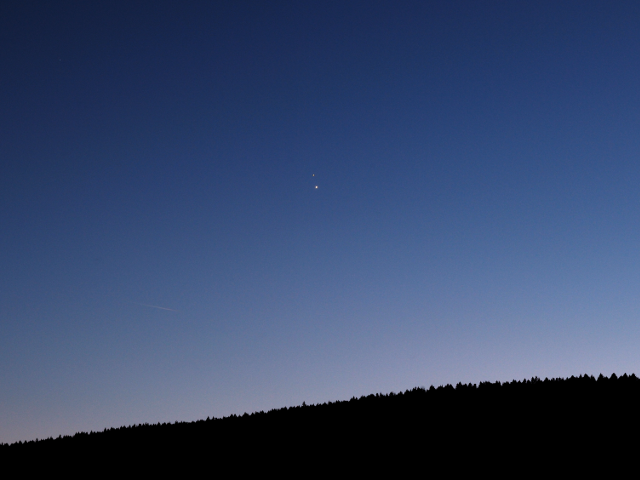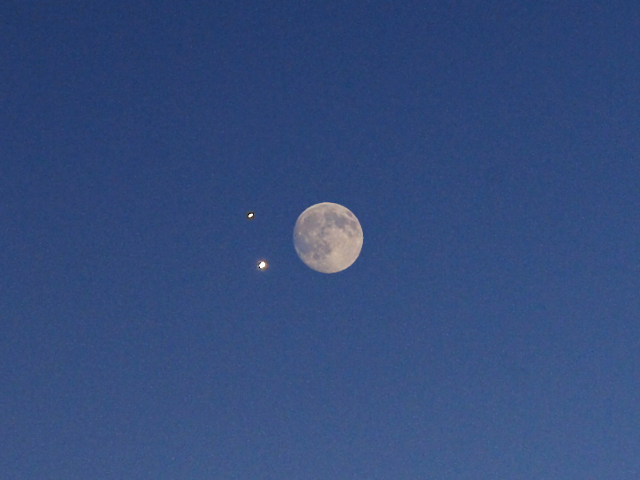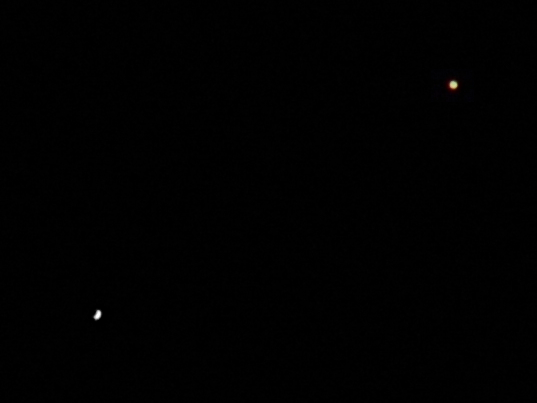« May 2015 | Main | July 2015 »
Tuesday, June 30, 2015
Venus and Jupiter at Dusk
Look toward the west a little after sunset today to see a spectacle in the sky: a close conjunction of Venus and Jupiter. Brilliant Venus is at the bottom and bright, but less dazzling, Jupiter is above. This picture was taken with a 50 mm normal lens and approximates the visual appearance. Tonight the planets are separated by only 0.3°, less than the width of the full Moon. To illustrate this, the following is a composite of an image of the conjunction and tonight's near-full Moon, which was rising as the planets were setting. I photographed both at the same scale and overlaid the images.
Brilliant Venus is at the bottom and bright, but less dazzling, Jupiter is above. This picture was taken with a 50 mm normal lens and approximates the visual appearance. Tonight the planets are separated by only 0.3°, less than the width of the full Moon. To illustrate this, the following is a composite of an image of the conjunction and tonight's near-full Moon, which was rising as the planets were setting. I photographed both at the same scale and overlaid the images.
 If you miss the closest conjunction tonight, the planets will remain strikingly close together in the sky for the next few days.
The juxtaposition of the two planets is only apparent. Venus is about 90 million kilometres from the Earth while Jupiter is 890 million kilometres away. Venus is so much brighter than Jupiter (which is more than ten times its size) because it is closer to the Sun and the Earth.
Update: On July 1st, 2015, the conjunction between Venus and Jupiter has widened to around 0.6°, just a bit more than the mean apparent diameter of the full Moon (it varies, due to the Moon's elliptical orbit), but it is still a spectacular sight in the western sky after sunset. Tonight I decided to see if I could take a picture which showed the two planets as they'd appear in a modest telescope. This is somewhat challenging, since Venus is presently 11.5 times brighter (on a linear scale) than Jupiter, and any exposure which shows Jupiter well will hopelessly overexpose Venus. So, I did what any self-respecting astrophotographer would do: cheat. I took two exposures, one best suited for Venus and one for Jupiter, and composited them. This is the result.
If you miss the closest conjunction tonight, the planets will remain strikingly close together in the sky for the next few days.
The juxtaposition of the two planets is only apparent. Venus is about 90 million kilometres from the Earth while Jupiter is 890 million kilometres away. Venus is so much brighter than Jupiter (which is more than ten times its size) because it is closer to the Sun and the Earth.
Update: On July 1st, 2015, the conjunction between Venus and Jupiter has widened to around 0.6°, just a bit more than the mean apparent diameter of the full Moon (it varies, due to the Moon's elliptical orbit), but it is still a spectacular sight in the western sky after sunset. Tonight I decided to see if I could take a picture which showed the two planets as they'd appear in a modest telescope. This is somewhat challenging, since Venus is presently 11.5 times brighter (on a linear scale) than Jupiter, and any exposure which shows Jupiter well will hopelessly overexpose Venus. So, I did what any self-respecting astrophotographer would do: cheat. I took two exposures, one best suited for Venus and one for Jupiter, and composited them. This is the result.
 You can easily see that Venus is a fat crescent, while Jupiter's disc is fully illuminated. The apparent angular diameter of two two planets is almost identical (because enormously larger Jupiter is so much more distant). This was still in late twilight, and I wasn't able to pop out the Galilean satellites. Jupiter would have set before those 4th magnitude objects became accessible.
Both images were taken with a Nikon D600 camera and 25 year old Nikkor 300 mm f/4.5 prime (non-zoom) lens. The image of Venus was taken at f/8 with ISO 1250 sensitivity and 1/1600 second exposure. (Why such high ISO and short exposure? The lens is sharper stopped down to f/8, and the short exposure minimises the chance of vibration or movement of the planet on the sky blurring the image.) The venerable lens has a substantial amount of chromatic aberration, which causes a red fringe around the bright image of Venus. I eliminated this by decomposing the image into its three colour components and using only the green channel, where the lens is sharpest. Since there is no apparent colour visible on Venus, this lost no information.
The Jupiter image was taken with the same camera, lens, aperture, and ISO setting, but at 1/400 second. I clipped the colour image of Jupiter from it and pasted it over the dim smudge which was Jupiter in the Venus image, preserving the relative position of the two planets.
All exposures were made from a fixed (non-guided) tripod in the Fourmilab driveway. (2015-07-01 21:42 UTC)
You can easily see that Venus is a fat crescent, while Jupiter's disc is fully illuminated. The apparent angular diameter of two two planets is almost identical (because enormously larger Jupiter is so much more distant). This was still in late twilight, and I wasn't able to pop out the Galilean satellites. Jupiter would have set before those 4th magnitude objects became accessible.
Both images were taken with a Nikon D600 camera and 25 year old Nikkor 300 mm f/4.5 prime (non-zoom) lens. The image of Venus was taken at f/8 with ISO 1250 sensitivity and 1/1600 second exposure. (Why such high ISO and short exposure? The lens is sharper stopped down to f/8, and the short exposure minimises the chance of vibration or movement of the planet on the sky blurring the image.) The venerable lens has a substantial amount of chromatic aberration, which causes a red fringe around the bright image of Venus. I eliminated this by decomposing the image into its three colour components and using only the green channel, where the lens is sharpest. Since there is no apparent colour visible on Venus, this lost no information.
The Jupiter image was taken with the same camera, lens, aperture, and ISO setting, but at 1/400 second. I clipped the colour image of Jupiter from it and pasted it over the dim smudge which was Jupiter in the Venus image, preserving the relative position of the two planets.
All exposures were made from a fixed (non-guided) tripod in the Fourmilab driveway. (2015-07-01 21:42 UTC)
Sunday, June 28, 2015
Reading List: Alas, Babylon
- Frank, Pat [Harry Hart Frank]. Alas, Babylon. New York: Harper Perennial, [1959] 2005. ISBN 978-0-06-074187-7.
- This novel, originally published in 1959, was one the first realistic fictional depictions of an all-out nuclear war and its aftermath. While there are some well-crafted thriller scenes about the origins and catastrophic events of a one day spasm war between the Soviet Union and the United States (the precise origins of which are not described in detail; the reader is led to conclude that it was an accident waiting to happen, much like the outbreak of World War I), the story is mostly set in Fort Repose, a small community on a river in the middle of Florida, in an epoch when Florida was still, despite some arrivals from the frozen north, very much part of the deep south. Randy Bragg lives in the house built by his ancestors on River Road, with neighbours including long-time Floridians and recent arrivals. some of which were scandalised to discover one of their neighbours, the Henry family, were descended from slaves to whom Randy's grandfather had sold their land long before the first great Florida boom, when land was valued only by the citrus it could grow. Randy, nominally a lawyer, mostly lived on proceeds from his orchards, a trust established by his father, and occasional legal work, and was single, largely idle, and seemingly without direction. Then came The Day. From the first detonations of Soviet bombs above cities and military bases around Fort Repose, the news from outside dwindled to brief bulletins from Civil Defense and what one of Randy's neighbours could glean from a short wave radio. As electrical power failed and batteries were exhausted, little was known of the fate of the nation and the world. At least, after The Day, there were no more visible nuclear detonations. Suddenly Fort Repose found itself effectively in the 19th century. Gasoline supplies were limited to what people had in the tanks of their cars, and had to be husbanded for only the most essential purposes. Knowledge of how to hunt, trap, fish, and raise crops, chickens, and pigs became much more important than the fancy specialties of retirees in the area. Fortunately, by the luck of geography and weather, Fort Repose was spared serious fallout from the attack, and the very fact that the large cities surrounding it were directly targeted (and that it was not on a main highway) meant it would be spared invasion by the “golden horde” of starving urban and suburban refugees which figure in many post-apocalyptic stories. Still, cut off from the outside, “what you have is all you've got”, and people must face the reality that medical supplies, their only doctor, food the orchards cannot supply, and even commodities as fundamental as salt are limited. But people, especially rural people in the middle of the 20th century, are resourceful, and before long a barter market springs up in which honey, coffee, and whiskey prove much more valuable than gold or silver. Wherever there are things of value and those who covet them, predators of the two footed variety will be manifest. While there is no mass invasion, highwaymen and thieves appear to prey upon those trying to eke out a living for their families. Randy Bragg, now responsible for three families living under his own roof and neighbours provided by his artesian water well, is forced to grow into a protector of these people and the community, eventually defending them from those who would destroy everything they have managed to salvage from the calamity. They learn that all of Florida has been designated as one of the Contaminated Zones, and hence that no aid can be anticipated from what remains of the U.S. government. Eventually a cargo plane flies over and drops leaflets informing residents that at some time in the future aid may be forthcoming, “It was proof that the government of the United States still functioned. It was also useful as toilet paper. Next day, ten leaflets would buy an egg, and fifty a chicken. It was paper, and it was money.” This is a tale of the old, weird, stiff-spined, rural America which could ultimately ride out what Herman Kahn called the “destruction of the A country” and keep on going. We hear little of the fate of those in the North, where with The Day occurring near mid-winter, the outcome for those who escaped the immediate attack would have been much more calamitous. Ultimately it is the resourcefulness, fundamental goodness, and growth of these people under extreme adversity which makes this tale of catastrophe ultimately one of hope. The Kindle edition appears to have been created by scanning a print edition and processing it through an optical character recognition program. The result of this seems to have been run through a spelling checker, but not subjected to detailed copy editing. As a result, there are numerous scanning errors, some obvious, some humorous, and some real head scratchers. This classic work, from a major publisher, deserves better.